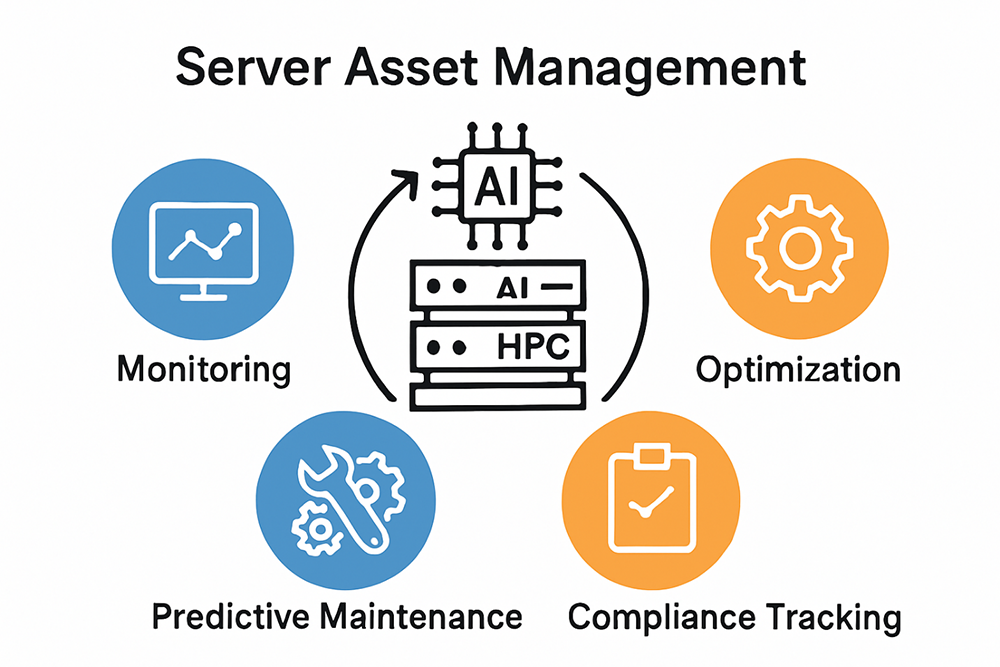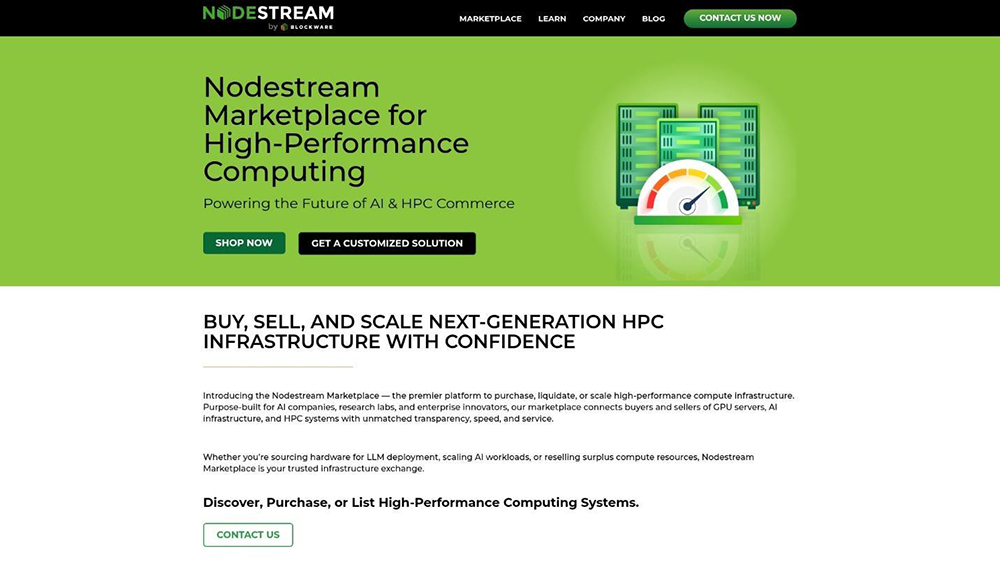
Managing the surge of AI and high performance computing servers in 2025 is tougher than ever and the numbers prove it. AI-powered platforms now track millions of server assets in real time and predictive maintenance is set to cut system failures by up to 40 percent. Most people focus on raw computing speed or fancy new hardware. The real breakthrough is happening with smarter server asset management that drives efficiency, slashes energy costs, and keeps massive systems running smoothly when everything else gets more chaotic.
| Takeaway | Explanation |
|---|---|
| Optimize resource allocation with precision | Successful asset management requires real-time insights into hardware capabilities and workload demands to balance computational power and efficiency. |
| Implement advanced monitoring techniques | Organizations should adopt sophisticated tracking methods that capture detailed performance metrics and help detect anomalies before they affect operations. |
| Utilize AI-driven platforms for management | Cutting-edge AI tools can automate asset monitoring processes, predict maintenance needs, and optimize resource allocation effectively. |
| Focus on predictive maintenance strategies | Establish comprehensive maintenance plans to foresee potential failures and prolong the lifecycle of server assets through ongoing diagnostics. |
| Prioritize power efficiency in operations | Effective management must incorporate intelligent power scaling mechanisms to maximize performance while ensuring energy efficiency and reducing costs. |

Server asset management for AI and High Performance Computing (HPC) systems presents a complex landscape of technical and operational challenges that require sophisticated strategic approaches. Organizations investing in advanced computational infrastructure must navigate increasingly intricate technological ecosystems while maintaining optimal performance, cost-effectiveness, and resource utilization.
Managing server assets in AI and HPC environments demands unprecedented precision in resource allocation. Modern computational workloads require granular understanding of hardware capabilities and workload requirements. According to a research study on machine learning asset management, organizations face significant challenges in tracking and efficiently deploying computational resources across complex infrastructure.
The intricate nature of server asset management involves multiple critical dimensions. Data center operators must continuously balance computational power, energy consumption, cooling requirements, and performance metrics. This multifaceted challenge requires advanced monitoring systems that can provide real-time insights into server utilization, thermal dynamics, and potential bottlenecks.

Power management represents a critical challenge in server infrastructure for AI and HPC. Research examining HPC power dynamics reveals that over-provisioned systems often struggle with inefficient resource allocation and excessive energy consumption. Organizations must develop sophisticated strategies that dynamically adjust computational resources based on immediate workload demands.
The complexity increases with emerging AI and machine learning workloads that require massive computational capacity while maintaining energy efficiency. Effective server asset management must incorporate intelligent power scaling mechanisms that can rapidly adapt to changing computational requirements without compromising system stability or performance.
Maintaining accurate and comprehensive server asset inventories presents another significant challenge. The GAO report on IT acquisition management emphasizes the critical need for precise tracking of computational resources, particularly in enterprise and government contexts. Organizations must develop robust systems that can:
Successful server asset management requires a holistic approach that integrates advanced monitoring technologies, predictive analytics, and flexible infrastructure design. As computational demands continue to evolve, organizations must remain agile and proactive in addressing these multifaceted challenges.
To help readers compare the core challenges in server asset management, here is a summary table of the primary challenges and their key focus areas:
| Challenge | Main Focus Area(s) |
|---|---|
| Resource Allocation & Optimization | Balance power, energy, cooling, and performance |
| Power & Performance Management | Dynamic resource allocation, energy efficiency, stability |
| Compliance & Inventory Management | Accurate tracking, regulatory compliance, rapid deploymen |
Effective server tracking in AI and High Performance Computing (HPC) environments requires a comprehensive and strategic approach that goes beyond traditional asset management methodologies. Organizations must implement sophisticated tracking mechanisms that provide real-time insights, ensure optimal performance, and maintain robust system reliability.
Advanced Resource Monitoring Techniques
Research on dynamic matrix factorization reveals innovative approaches to monitoring resource usage in high-performance computing systems. By transforming multi-dimensional resource data into low-dimensional representations, organizations can gain unprecedented visibility into system behavior and performance characteristics.
Effective server tracking involves implementing comprehensive monitoring strategies that capture granular details about computational resources. This includes tracking hardware specifications, real-time utilization metrics, thermal performance, and energy consumption. Advanced monitoring solutions enable organizations to:
Configuration management research highlights the critical importance of maintaining precise and comprehensive documentation for server assets. Effective tracking goes beyond simple inventory management, requiring a holistic approach that integrates detailed configuration records, software versions, and system dependencies.
A survey on asset management in machine learning emphasizes the unique challenges of tracking assets in AI and machine learning environments. Effective tracking requires specialized approaches that address the complex nature of computational resources used in advanced AI workloads.
Successful high-performance server tracking demands a proactive, technology-driven approach that combines advanced monitoring techniques, precise documentation, and adaptive management strategies. Organizations must continuously evolve their tracking methodologies to keep pace with the rapidly changing landscape of AI and HPC infrastructure.
Below is a summary table highlighting the best practices for effective high-performance server tracking and their key benefits:
| Best Practice | Key Benefits |
|---|---|
| Advanced Resource Monitoring Techniques | Real-time insights, anomaly detection, performance clarity |
| Configuration Management & Asset Documentation | Robust records, easy audits, historical traceability |
| Machine Learning Asset Tracking Strategies | Reproducibility, compliance, detailed metadata |
Optimizing asset management for GPU and AI servers requires a strategic approach that balances performance, energy efficiency, and computational scalability. Organizations must develop sophisticated methodologies that address the unique challenges of managing high-performance computing infrastructure in an increasingly complex technological landscape.
Power Management and Efficiency Strategies
Research on sustainable supercomputing reveals critical insights into GPU power optimization. The study demonstrates that implementing advanced power capping techniques can significantly reduce energy consumption while maintaining computational performance. Organizations can leverage these strategies to:
Power management goes beyond simple energy reduction. It involves creating intelligent systems that dynamically adjust computational resources based on workload requirements. This approach allows organizations to maximize computational density while maintaining optimal thermal and energy profiles.
Research on HPC infrastructure considerations highlights the importance of modular and high-density server designs. Organizations must focus on creating flexible infrastructure that can adapt to evolving computational demands. This involves:
Modern AI and HPC environments require infrastructure that can rapidly scale to meet complex computational workloads. Learn more about emerging computing infrastructure trends to understand how organizations are reimagining computational resource management.
Advanced asset management for GPU and AI servers demands a proactive approach to hardware maintenance and lifecycle management. Organizations must develop comprehensive strategies that:
Successful optimization requires a holistic view of server assets that considers not just immediate performance needs, but long-term computational sustainability. This approach involves continuous monitoring, intelligent resource allocation, and strategic investment in infrastructure that can adapt to rapidly evolving technological landscapes.
The future of GPU and AI server asset management lies in creating intelligent, adaptive systems that can dynamically respond to computational challenges while maintaining optimal performance, energy efficiency, and operational reliability.
The landscape of server asset management for AI and High Performance Computing (HPC) is rapidly evolving, with innovative tools and solutions emerging to address the complex challenges of modern computational infrastructure. Organizations must stay ahead of technological advancements by adopting cutting-edge management platforms that offer comprehensive monitoring, optimization, and predictive capabilities.
AI-Driven Asset Management Platforms
Research on industrial asset management frameworks reveals breakthrough approaches to automating complex asset operations. The AssetOpsBench framework demonstrates the potential of AI agents in transforming asset management strategies. These advanced tools can:
AI-powered solutions are revolutionizing how organizations track and manage their computational resources. By leveraging machine learning algorithms, these platforms can provide unprecedented insights into hardware performance, potential failure points, and optimization opportunities.
The HPCClusterScape research introduces advanced visualization tools that enhance transparency and efficiency in shared high-performance computing clusters. These sophisticated monitoring solutions offer:
Modern asset management requires more than simple tracking. Organizations need insights into advanced computational infrastructure that provide actionable intelligence and predictive capabilities.
Emerging runtime architectures are transforming how organizations manage distributed computing resources. The latest research highlights innovative solutions that support hybrid HPC and machine learning workflows, enabling:
The most effective tools in 2025 will go beyond traditional asset tracking. They will provide intelligent, adaptive solutions that can dynamically respond to the complex demands of AI and HPC environments. These platforms will combine predictive analytics, real-time monitoring, and automated optimization to create a new generation of asset management solutions.
Successful organizations will invest in tools that offer holistic views of their computational infrastructure, providing unprecedented visibility, control, and strategic insights into their most critical technological assets.
The main challenges include resource allocation complexity, power and performance management constraints, and compliance and inventory management issues. These factors require advanced strategies to ensure efficient operations and optimal resource utilization.
Organizations can optimize resource allocation by leveraging real-time insights into hardware capabilities and workload demands, employing advanced monitoring techniques, and utilizing AI-driven asset management platforms.
Predictive maintenance plays a crucial role in server asset management by forecasting potential failures, extending asset lifecycles, and ensuring system reliability through ongoing diagnostics and proactive maintenance strategies.
Recommended tools include AI-driven asset management platforms, advanced visualization and monitoring solutions, and hybrid workflow management tools that enhance efficiency and provide comprehensive insights into computational resources.
Struggling to keep up with the ever-changing demands of AI and HPC server asset management? The challenges of resource allocation, power optimization, and predictive maintenance highlighted in this article are real pain points for organizations that rely on high-performance computing. As your systems grow more powerful, missing a single hardware shift can mean higher costs and lost productivity. You need visibility, transparency, and the power to act fast. See what sets enterprise-grade procurement apart in the Uncategorized Archives – Blockware Solutions for additional insights.

Experience instant access to verified GPU servers, AI-optimized hardware, and full-scale support at https://nodestream.blockwaresolutions.com. Discover a transparent marketplace designed for secure transactions, bulk orders, and real-time inventory—so your AI and HPC infrastructure is always ready for what comes next. Get your team the advantages of fast provisioning and expert guidance. Visit our platform now to streamline your server infrastructure management before your next big project is at risk.